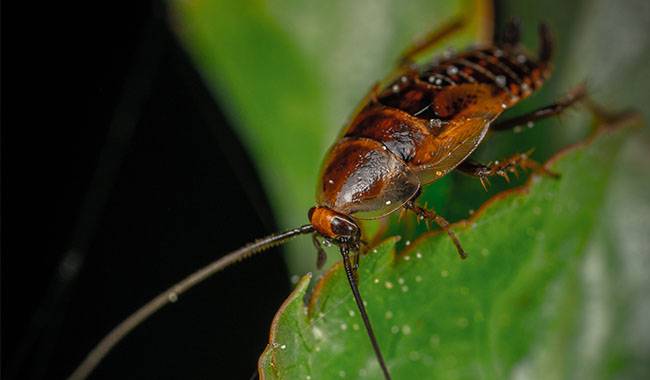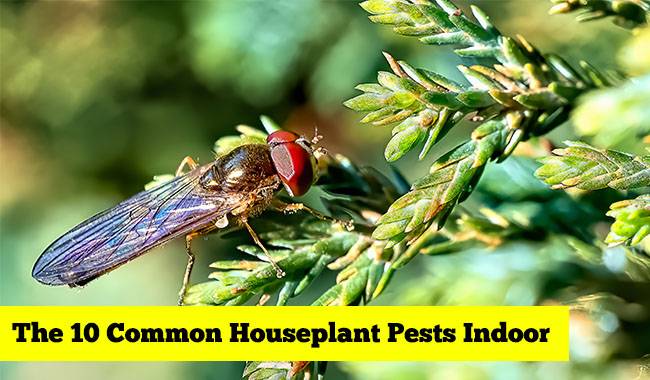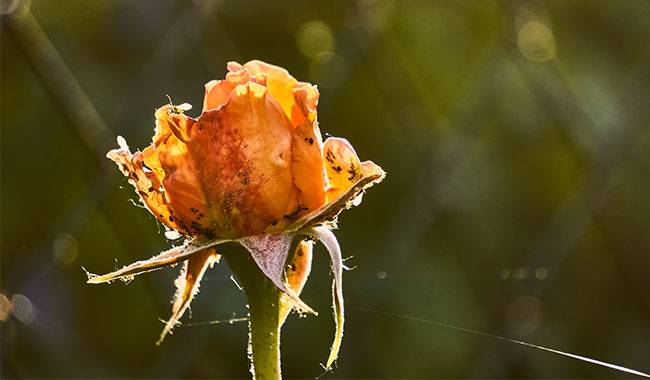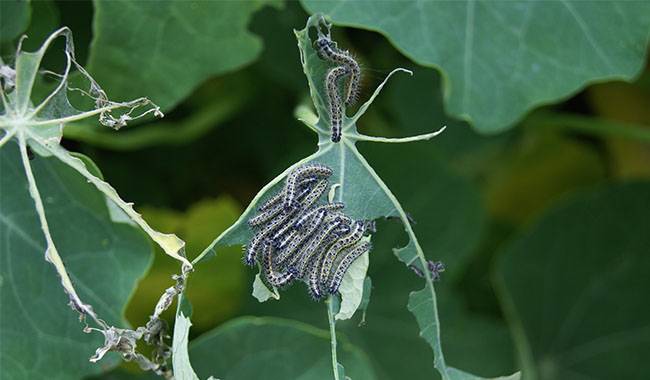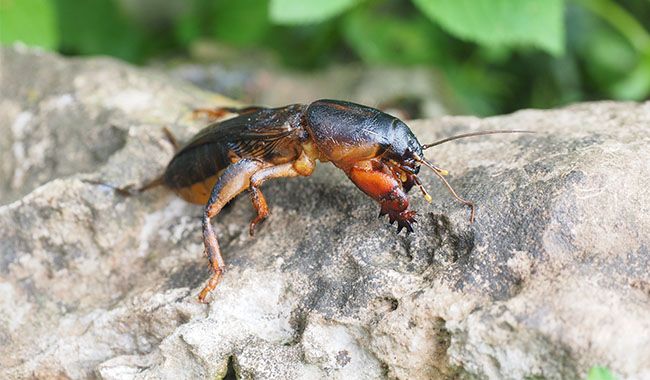
Mole cricket, or Gryllotalpidae, is one of the most vicious pests of vegetable crops. Almost all vegetable crops, especially seedlings, cucurbits, and industrial crops (potatoes), are harmed by this polyp. In natural conditions, Mole cricket inhabits moist places in loose, light soils rich in organic matter. On arable land, it prefers manure and compost, as well as vegetable crop beds in the sun.
MOLE CRICKET FACTS
Around 1900, three species of Mole cricket were inadvertently introduced into the southeastern United States and caused severe plant damage. The introduced species were: Neoscapteriscus abbreviatus (Scudder), Neoscapteriscus borellii (Giglio-Tos), and Neoscapteriscus vicinus (Scudder). These are not the only Mole cricket found in North America, but they are the most devastating. For example, a native species, Neocurtilla hexadactyla (Perty) is widely distributed in eastern states west to South Dakota and Texas, including southern Ontario, but is not a pest. European Mole cricket, Gyllotalpa gryllotalpa (Linnaeus), has been introduced from Europe to the northeastern states but is of little significance. Neoscapteriscus didactylus (Latreille) invaded Puerto Rico from South America before 1800 and caused considerable damage to crops on the island caused considerable crop damage, but did not occur elsewhere in the United States.
DESCRIPTION OF MOLE CRICKET
Mole cricket belongs to a group of straight-winged insects. Mole cricket is dark brown in color with a transition to olive on the abdomen. With a beard and tail whiskers (filamentous appendages) on the hindgut, Mole cricket reaches a length of 3-4inch (8-10cm). The thorax has large eyes and a gnawing muzzle. The forelimbs are modified into shovel-like diggers (like a mole cricket). On its back, it has hard and soft wings that help it fly from one place to another in warm weather.
MOLE CRICKET’S HABITAT AND BREEDING SITES

Overwintering adults live in their “quarters,” which can be found 40-80inch (1-2m) outside of frozen soil or in manure and compost. The insects emerge from hibernation when the soil in the upper layers reaches °F (8-10°С). During the daytime, when the temperature is 53-59 °F (12-15 °С), mass emergence from winter sleep is observed for active feeding and reproduction.
The main breeding sites are manure, humus, and compost. During the same period, female Mole cricket mates and makes a soil chamber nest no more than 4-8inch (10-20 cm) from the soil surface. Soil treatment of 4-6inch (10-15 cm) in spring can destroy the Mole cricket nest.
In the spring, check the vegetable garden bed carefully before starting work.
The location of Mole cricket nests can be easily identified by the “bumps” protruding from the ground on the sunny side of the bed. Around the “bump,” spring weeds are “slashed” 8-12inch (20-30cm) to allow better sunlight to reach the nest. If the soil surface is moist, the tracks leading to the nest are clearly visible, where up to 400 eggs mature. The eggs are grayish-yellow and slightly smaller than peas. Depending on the weather conditions, embryo development lasts 10-25 days. During the last ten days of May, the larvae (pupae) of Mole cricket, light yellowish-brown, winged buds, leave the nest and begin to feed actively. They resemble translucent, dirty yellowish flies. The food of the larvae is quite extensive: ground cover, earthworms, soil insects, plants (especially young seedlings). During this period of growth and development, young Mole cricket can destroy up to 50% of plantings and crops. During their development, young beetles (nymphs) go through 5 to 10 molts and then reach the adult stage. The molting and maturation period takes 1 to 2 years, depending on environmental conditions. Like adult Mole cricket, young larvae do not tolerate cold weather, so they will go to a depth of 40-80inch (1-2m) if there is no manure, compost, or other warm places nearby. After the fifth molt, females become sexually mature and capable of reproduction.
CONTROL MEASURES FOR MOLE CRICKET
Preventive measures
General Operations
- In a private home, you need an area to store and mature manure and compost. If the area is a mess of piles of manure, scattered food waste, it means that Mole cricket (and other pests and diseases) have the best conditions for overwintering and reproduction.
- It is best to apply manure and compost to the soil after maturity. If you intend to apply fresh manure, it should be brought to the vegetable garden after harvest and piled into small heaps in a staggered fashion. In this case, the vegetable garden is dug in late autumn. Before digging, the pile is stirred up, the adult Mole cricket that has frozen in the cold is removed, the manure is spread on the plot, and the pile is dug to a depth of 10-12inch (25-30 cm).
- The young Mole cricket is a “gourmet” and does not tolerate unpleasant odors from food. In particular, it does not tolerate the smell of root excrement of alder and bird cherry. As a rule, this insect tries not to break the boundaries of the plot, but its unpleasant “scent” makes it leave the place it inhabits at the first opportunity. Velvet and marigold are similarly allergic to this insect. Flower beds planted with potatoes, eggplants, and tomatoes will not have Mole cricket coming during the vegetation period. They will go elsewhere.
Agricultural techniques
- A good vegetable garden involves the basic principle of crop rotation. It is the correct distribution of crops that helps to implement all plant care measures in a timely manner, prompting a significant reduction in the number of pests per unit area.
- Post-harvest shredding of crop residues, deep digging (preferably turning the ground in southern regions), and high-quality spring and summer inter-row tillage can destroy up to 70-90% of soil and plant pests. Deep loosening of 5-6inch (13-15 cm) inter-row tillage is particularly effective until the end of June, as it does not damage the young roots of the planted plants but destroys underground communication where Mole cricket overwinters and kills their eggs and larvae.
- On acidified soils, placing large amounts of grass ash in the perimeter ditches and paths will deter pests. Note! On neutral and alkaline soils, applying large amounts of ash is not recommended. Increasing the alkalinity of the soil has an inhibiting effect on some vegetable crops.
- Watering promotes crop development and increases resistance to pests. Excessive watering leads to a significant increase in their numbers.
- All crop protection measures must be carried out according to the developmental cycle of pests, including Mole cricket. Premature or delayed protection will not produce meaningful results. Adults may die, but the younger generation (300-400 Mole cricket per brood) will invade the garden.
PROACTIVE CONTROL MEASURES
In private plots, chemical control measures for Mole cricket are best used as a last resort. It is a matter of health for adults and children, pets, birds, and other residents in the limited space of the site. For this reason, it is always better to start with biological control measures. In the case of epizootic infestations of all ages (3-5 per 11 square feet), the use of chemicals is preferable.
BIOLOGICAL AGENTS
Biological agents are made based on live and effective soil microbiota and will not harm the health of your family or warm-blooded animals. Biological agents are divided into 2 groups: repelling and eliminating garden pests.
FROM MY EXPERIENCE
I have worked in my dacha for more than 25 years. I have grown a large number of vegetables and other crops in my own garden, observing a crop rotation system that has been in place for many years. Over the years, I have developed my own beadle weed control methods and now have a negligible amount of beadle weed in my garden.
Roundup refers to my use of natural medicines. Excellent biological preparations based on extracts and essences of cayenne pepper, wormwood, thistle, garlic oil, tar, and fish extracts. Before sowing seedlings, I dilute the aromatic liquid in 1.3 Gal (5 liters) of water, soak the roots of the plants and plant the crop. In addition, I cover the soil with straw or other light material to create a cool space around the plants. The stuffy smell and cold keep Mole cricket away from the plants. However, this product only repels pests for one season.
The biological preparation of Green Beauveria, based on the fungal insecticide Green Beauveria, has a longer-lasting effect. I mixed the insecticide with residual sunflower oil and added it spoonful by spoonful to several holes leading to the nesting chamber. Stifling insects crawled out.
If I didn’t have time to collect them, they were eaten by birds, cats, hedgehogs, lizards, beetles, ants, and shrews. Pets will not be killed by this drug but may get sick. Therefore, it is better to collect Mole cricket.
I use every 3 years an effective granular continuous-action insecticide-biological preparation, which is available at home depot. Its composition is harmless to humans and other warm-blooded animals. The effective effect lasts only 25-30 days, so the procedure should be repeated during the growing season, especially for late and repeated plantings.
The preparation is sprinkled on the soil around the planted plants (only a few grains are needed). When replanting, I use a different method: make a 2inch (5cm) deep trench, moisten it slightly, sprinkle the preparation on the bottom, and cover it with a small layer of soil – no more than 0.4inch (1cm). Appetizing bait will kill black Mole cricket of all ages.
CHEMICAL PREPARATIONS
When Mole cricket invades vegetable gardens, and ecological measures do not produce the desired effect, drastic measures must be taken. The chemical industry offers a wide range of products to kill Mole cricket. These products include Prestige and others. They have their own specific methods of application, usually specified on the packaging of the insecticide, but the end result is the same: killing the maximum number of pests within a few days or weeks.
For example, to protect bell peppers, tomatoes, eggplants, and cabbage, the most commonly used product is Actara, which kills Mole cricket of all ages within 1.5-2 h. The working solution for plant treatment is prepared in the ratio of 1.5 g/0.25 Gal warm water.
ACMT are carbamate insecticides that act by increasing the amount of acetylcholine (a neurotransmitter) in the target organism. ACMT can be applied to furrows of 1-2inch (2.5-5 cm) made within the row spacing for potatoes, tomatoes, and cabbage. Cover the furrow with a small layer of soil and moisten it well (without flooding).
Prestige Soluble Concentrate has a broader range of action. The preparation is used to treat the root system of any seedling. Prestige is placed in a solution (10 ml / 0.25 Gal water) in the ground for 2-3 hours before planting the roots of seedlings.
The alluring smell of Phenoxin is especially attractive to women. They try to make a nest closer to pleasant food. Once the pests have eaten the product, they are killed. Phenoxin can be applied to manure, humus, and composted ditches or open spaces. The pellets must always be covered with soil. If they are not applied as intended, they will gradually dissolve in the soil and not harm it.
Eliminate Mole cricket with chemical insecticides such as Bayer Advanced. Merit is usually applied in June or July to kill small wakame. They can be controlled with sprays, granules, or bait. Apply when the night temperature is at least 60 °F (16 °С) and irrigate the area beforehand. Moist soil helps penetration insecticides and encourages Mole cricket to come to the surface to feed on the bait.
PREPARING POISONED BAIT
I use bait once in 4-5 years and then switch to the protection method described above (see “From my experience” section). I prepare the chemical bait in the following way. I boil 4.4 Lb (2 kg) of wheat until it is half cooked, cool it, add 1-2 ampoules (usually 1-25 ml per ampoule) of organophosphorus insecticide, and add 2-3 tablespoons (preferably homemade aromatic) of sunflower oil.
I mix it thoroughly. I make furrows 1-2inch (2.5-5cm) deep along and across 20inch (50cm) in the vegetable garden. With gloves on, carefully spread the bait into the trench and cover it with a 0.8-1.2inch (2-3cm) layer of soil. If the trenches are dry, use a fine stream from a watering can to wet them. The first time I performed this operation, I collected half a 1.3 Gal (5 liters) pot of adults. This year I collected some.
Please remember! All chemicals are very toxic. Remember to take personal protection when working (jacket, gloves, goggles, hat, respirator, or laminated bandages). After working with insecticides, take a shower and change into fresh clothes.
FOLK METHODS OF CONTROLLING MOLE CRICKET
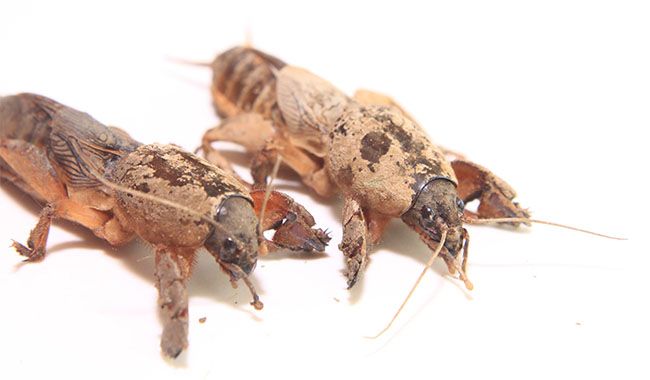
A large number of so-called “folk methods” can be found on websites and in the literature. Not all of them are effective – some are not effective at all. If you need an effect, you must be guided by Mole cricket’s “habits.” They are attracted to the smell of alcohol. Meaning.
- a case of sour beer buried in the ground would be a good trap.
- a 0.5-0.8 Gal (2-3) liter glass container with a wide opening, smear honey inside (where the opening extends) will attract Mole cricket with sweetness. You can pour some jam on the bottom. Bury the container flush with the soil and cover it with a small layer of grass and semi-bent plywood. Drop to the bottom of the jar, and Mole cricket won’t come out.
They do not tolerate the smell of some herbs and flowering insecticides. Planting marigolds, velvet lawn, chrysanthemums between crops (potatoes, tomatoes, eggplants) will stop Mole cricket from coming out, as will the excrement of alder roots.
Around vegetable plantings, if you find any Mole cricket holes, pour in soapy water made of washing powder or laundry detergent. When they gasp for air, Mole cricket will crawl to the soil surface. If collected in time, they will be easily killed.
Dried chicken manure can be spread between the rows. Mole cricket can’t stand its smell, so they leave.
More related information about Garden Pests




